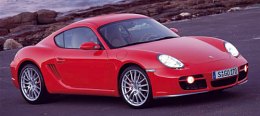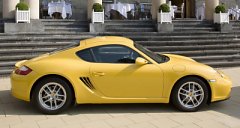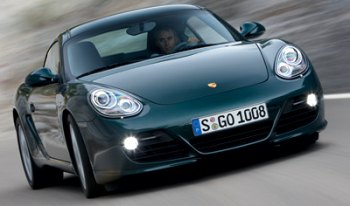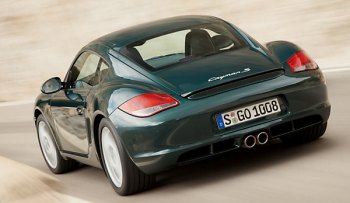| Published
on 6
Oct 2005 |
All rights reserved.
|
|
|
Although
Porsche wants to sell the Cayman as an independent model, everybody
knows it is actually a "Boxster Coupe SS". From its internal codename
987 C7S you will know its relationship with the Boxster. Basically, the
two cars share the same chassis, with the same wheelbase, width and
tracks. Although every sheet metal is
different, they share windscreen, doors, cabin and 40 percent other
components, while the remaining components either come from 911 or are
adapted from both cars. They are also assembled at the same place,
Finland, by Valmet.
 However,
looking from outside the
Cayman S delivers a vastly different shape. Thanks to the swoopy steel
roof which flows smoothly towards the tail, it looks rounder and almost
like a mid-engined version of 911. The fixed roof also increased
torsional rigidity by an astonishing 150 percent (did we feel the
Boxster lack of stiffness?) and lowers drag coefficient from the
roadster's 0.30 to 0.29. However,
looking from outside the
Cayman S delivers a vastly different shape. Thanks to the swoopy steel
roof which flows smoothly towards the tail, it looks rounder and almost
like a mid-engined version of 911. The fixed roof also increased
torsional rigidity by an astonishing 150 percent (did we feel the
Boxster lack of stiffness?) and lowers drag coefficient from the
roadster's 0.30 to 0.29.
The
stiff
chassis allows Porsche to tune its suspension springs and dampers more
precisely, but it retains the tires, wheels and brakes from the Boxster
S because they are considered to be sufficient to handle the modest
gain of 15 horsepower and 15 lbft of torque from the 200 cc larger
flat-six engine.
 The
Cayman S sits between the top Boxster and the base 911. In UK, it is
sold for £44,000, versus the £39,000 Boxster S and the
£58,000 911 Carrera. As a result, its survival space is rather
narrow. To ensure it won't steal sales from the more profitable 911,
Porsche deliberately limited its performance. It can easily put the
911's 325hp 3.6-litre or even 355hp 3.8-litre flat-six into the Cayman
S, but it eventually gave it a 3.4-litre version of the boxer engine,
made by combining the 96 mm bore of the 911 Carrera engine and the 78
mm stroke of the Boxster S engine. Like both engines, it has VarioCam
Plus variable valve timing and lift system and a variable intake
manifold, but the tuning is mild enough to deliver only 295 horsepower
at 6250 rpm. I suppose the big bore and short stroke engine could have
delivered 310-315 horsepower if it were not limited. The maximum torque
of 251 lbft is also disappointing. Unusually, the torque curve is flat
across a wide band from 4400 to 6000 rpm. This implies that Porsche
programmed the engine management system to limit its top end power. The
Cayman S sits between the top Boxster and the base 911. In UK, it is
sold for £44,000, versus the £39,000 Boxster S and the
£58,000 911 Carrera. As a result, its survival space is rather
narrow. To ensure it won't steal sales from the more profitable 911,
Porsche deliberately limited its performance. It can easily put the
911's 325hp 3.6-litre or even 355hp 3.8-litre flat-six into the Cayman
S, but it eventually gave it a 3.4-litre version of the boxer engine,
made by combining the 96 mm bore of the 911 Carrera engine and the 78
mm stroke of the Boxster S engine. Like both engines, it has VarioCam
Plus variable valve timing and lift system and a variable intake
manifold, but the tuning is mild enough to deliver only 295 horsepower
at 6250 rpm. I suppose the big bore and short stroke engine could have
delivered 310-315 horsepower if it were not limited. The maximum torque
of 251 lbft is also disappointing. Unusually, the torque curve is flat
across a wide band from 4400 to 6000 rpm. This implies that Porsche
programmed the engine management system to limit its top end power.
No wonder
the car is just 0.1 seconds quicker to 60 mph and 4 mph faster at the
top end. 10 years ago, any cars taking 5.1 seconds from 0 to 60 mph
must be very fast cars. Today, the Porsche sports car found itself
trailing many class rivals such as Corvette, BMW M3, Mercedes SLK55 and
TVR of various kinds.
However, none of the above cars drive as sweet as the Porsche. We
knew
this already in the launch of 987, but in the stiffer coupe form, it
has elevated to another level. Its handling is ultra-precise and
responsive. The combination of stiff chassis and perfectly judged
damping deals with surface changes so well that they can hardly
unsettle the steering and traction. This means no matter on what
surfaces the Cayman S just grip and go.
 The
mid-engined layout also gives Cayman S a lot of advantage over rivals.
Remarkable balance and low inertia at both ends allow it to steer more
responsively and accurately. Driving it requires no more than basic
instinct, especially when the engine is so smooth and linear while the
gearshift so initiative. In fact, the level of control and feel exceeds
that of the finest 911, making it the best handling Porsche to date.
And you know, the best handling Porsche must be the best handling car
in the world. The
mid-engined layout also gives Cayman S a lot of advantage over rivals.
Remarkable balance and low inertia at both ends allow it to steer more
responsively and accurately. Driving it requires no more than basic
instinct, especially when the engine is so smooth and linear while the
gearshift so initiative. In fact, the level of control and feel exceeds
that of the finest 911, making it the best handling Porsche to date.
And you know, the best handling Porsche must be the best handling car
in the world.
Inside, Cayman shares the same cockpit
with Boxster. It does not have enough style and exclusive feel, but so
did the traditional Porsches. Behind the cockpit and under the tailgate
is a 260-litre loading area. In addition to the 140 litres front
luggage compartment, it is more practical than the roadster.
However, my dream is still a more
powerful Cayman. The Cayman has an inherently better chassis than the
911. It is ridiculous to limit the better car in order to save the
poorer car. Porsche should follow Ferrari to place its models
horizontally instead of vertically. 911 can sell because of its lovely
character, not necessarily because it is faster and more powerful than
other Porsches. 20 years ago, Porsche had 3 similarly quick cars in its
lineup: 944 Turbo, 911 Carrera and 928. Each represented different
character. That was the golden era of Porsche in my mind. |
Verdict:      |
Published
on 7
Aug 2006
|
All rights reserved.
|
|
Cayman 2.7
|
|
 To
avoid being regarded as "Boxster Coupe", Porsche deliberately launched
the Cayman line in the form of Cayman S first. Its 3.4-litre engine
really gave it sufficient advantage over Boxster S. In addition to the
superior handling of coupe, so far this strategy has been successful.
Most people see Cayman bridging between the entry-level Boxster and the
expensive 911. But as the base Cayman arrived, its market positioning
becomes mushy. To
avoid being regarded as "Boxster Coupe", Porsche deliberately launched
the Cayman line in the form of Cayman S first. Its 3.4-litre engine
really gave it sufficient advantage over Boxster S. In addition to the
superior handling of coupe, so far this strategy has been successful.
Most people see Cayman bridging between the entry-level Boxster and the
expensive 911. But as the base Cayman arrived, its market positioning
becomes mushy.
 First,
its engine displaces the same 2687 cc as the base Boxster. Initially,
Porsche claims it adopt the 911's VarioCam Plus
instead of the old VarioCam, which means adding a two-stage variable
valve lift. The result is a rather forgettable addition of 5 horsepower
(now 245hp) and 2 lbft of torque (now 201 lbft). For a 2.7-litre class
engine, these figures are undoubtedly remarkable, but rival
coupes or roadsters usually employ 3.0 or even 3.5-litre engines which
possess 270 to 300 horsepower and far superior torque. That make the
Cayman rather weak. Moreover, just a month after its introduction,
Porsche announced the Boxster line was also upgrading to the same
engines as Cayman and Cayman S. This mean now Cayman has lost
its performance advantage over Boxster. It makes you realize Cayman is
actually the coupe version of Boxster. It makes you wonder why
Zuffenhausen dare to charge more money for the coupe than the open-top
version, in contrary to conventional wisdom. In UK, the Cayman costs
£36,000, versus £33,000 for Boxster, £40,000 for
Boxster S and £44,000 for Cayman S. First,
its engine displaces the same 2687 cc as the base Boxster. Initially,
Porsche claims it adopt the 911's VarioCam Plus
instead of the old VarioCam, which means adding a two-stage variable
valve lift. The result is a rather forgettable addition of 5 horsepower
(now 245hp) and 2 lbft of torque (now 201 lbft). For a 2.7-litre class
engine, these figures are undoubtedly remarkable, but rival
coupes or roadsters usually employ 3.0 or even 3.5-litre engines which
possess 270 to 300 horsepower and far superior torque. That make the
Cayman rather weak. Moreover, just a month after its introduction,
Porsche announced the Boxster line was also upgrading to the same
engines as Cayman and Cayman S. This mean now Cayman has lost
its performance advantage over Boxster. It makes you realize Cayman is
actually the coupe version of Boxster. It makes you wonder why
Zuffenhausen dare to charge more money for the coupe than the open-top
version, in contrary to conventional wisdom. In UK, the Cayman costs
£36,000, versus £33,000 for Boxster, £40,000 for
Boxster S and £44,000 for Cayman S.
 Costing
£8,000 less than the Cayman S, you might think Cayman 2.7
represent good value for money. But this case is just not the same as
Lotus Elise S, which loses little real world performance to its more
expensive sister. In contrast to the case of Lotus, the 2.7 engine is
far weaker than the 3.4 engine. It needs to be revved hard to exploit
reasonable performance, although it is smooth and the gearshift is
eager. Official performance figures are 160 mph and 0-60 mph in 5.8
seconds. If they are not over optimistic, at least subjectively it does
not feel as quick. Costing
£8,000 less than the Cayman S, you might think Cayman 2.7
represent good value for money. But this case is just not the same as
Lotus Elise S, which loses little real world performance to its more
expensive sister. In contrast to the case of Lotus, the 2.7 engine is
far weaker than the 3.4 engine. It needs to be revved hard to exploit
reasonable performance, although it is smooth and the gearshift is
eager. Official performance figures are 160 mph and 0-60 mph in 5.8
seconds. If they are not over optimistic, at least subjectively it does
not feel as quick.
In the case of Lotus Elise, we
applauded the base car has the same superb handling as the more
expensive car. In the case of Porsche Cayman, the handling is slightly
compromised by the use of smaller and higher profile tires. Of course,
you can always pay extra money for bigger wheels and brakes, sportier
tires and even a 6-speed gearbox and adaptive dampers (PASM), but
that's not the point for an entry-level Cayman. Even if you are willing
to pay for these, you will find it lacks power to exploit the chassis.
In fact, the superior chassis rigidity of Cayman is wasted by the
underpowered engine. To certain extent, Cayman 2.7 is a rather
unnecessary product from Zuffenhausen. Boxster will cope as well with
the 2.7 engine, save you £3,000 and add the joy of open air
motoring. |
Verdict:     |
Published
on 24
Dec 2008
|
All rights reserved.
|
|
2009 Cayman update
|
|
 More power and an excellent gearbox,
Cayman is closer to perfection...
More power and an excellent gearbox,
Cayman is closer to perfection...
From
outside, the “new” Cayman is hardly new. If it is not parked beside the
old car, you may not notice its new headlamps, reshaped front intakes
and taillights. The proportion of its body is still hopelessly outdated
– it combines a short wheelbase with very long overhangs, plus a low
waist line, very much the proportion of 1980s. On the other hand, the
round shape remind us the sports cars of 1960s. Even though the basis
of this car (Boxster) is already 12 years old, it should not have
looked more retro than the 45-year-old 911, should it ?
However, once you drive this car on road, let it be a twisty mountain
road or a session of unlimited Autobahn, you can’t help praising it as
one of the best sports cars in the world. Not even a 911 can match it.
This has been the case since its birth 3 years ago. It will continue
for many more years following the latest update.
Porsche hasn't altered its chassis and suspensions much because it is
still deemed to be first class. What it need (and desperately needed)
is more power from the boxer engines. Today, any Japanese six-cylinder
motors can easily pump out 300 or more horsepower. Cayman could no
longer stick with the previous 245 hp 2.7 and 295 hp 3.4-liter engine.
In the latest update, the base engine has been enlarged to 2.9 liters,
lifting output by 20 horsepower and 20 lb-ft of torque. Moreover, it
finally abandoned the 5-speed gearbox for the same 6-speeder as Cayman
S. Also the same brakes. Porsche's entry-level customers have never
been so well treated.
The Cayman S engine still displaces 3.4 liters, but it is actually a
new motor. The engine block is made in 2 pieces instead of 4, which
makes it stiffer and lighter. The bore is increased by 1mm to 97mm,
while stroke is reduced by 0.5mm to 77.5mm, taking the total capacity
to 3436 cc, or 50 cc more than before. This lead to a higher red line
and freer top end performance. However, the most significant change is
the introduction of direct fuel injection and higher, 12.5:1
compression ratio. These modifications lifted its output to 320 hp and
273 lb-ft. In other words, almost the same as the base 911 Carrera 3.6.
 This car delivers far more than the
sum of its components...
This car delivers far more than the
sum of its components...
On the road, the new engine of Cayman
S is keener to rev, sounds throatier and delivers noticeably stronger
mid-range punch. Coupling to the fact that it is still relatively
lightweight - for example, 180 kg lighter than Nissan 370Z -
performance is no longer a weakness. We expect 0-60 mph acceleration
will take less than the 4.9 seconds claimed by Porsche. Top speed is in
excess of 170 mph. If you tick the optional "Sport Plus" package, its
electronic launch control can improve 0-60 mph by a further 0.2 seconds
and 0-100 mph by 0.3 seconds.
Apart from engine, another important improvement is the new 7-speed PDK
twin-clutch gearbox. Its seamless and instantaneous gearshift takes the
driving satisfaction to another level, although drivers will have to
get use to its strange control, which uses 2 switches on the steering
wheel instead of the more popular shift paddles pioneered by Ferrari.
Compare with the standard manual box, the PDK achieves both faster
acceleration and lower fuel consumption. The latter is partly due to
its overdrive 7th gear.
The last but not least improvement is the availability of a limited
slip differential to both Caymans. It should have appeared from the
beginning to please those might take their Caymans to track days. Now
the car can power slide is a controlled manner.
Cayman is an unusual sports car, one that ignores the fashion and stick
to traditional core values, one that delivers far more than the sum of
its components, one that truly satisfies keen drivers without resorting
to big power. Its class-leading position is rock steady.
|
Verdict:      |
Published on 27
Feb 2011
|
All rights reserved.
|
|
Cayman R
|
|
Lightweight hardcore Porsches are always tempting. Last year we
appraised Boxster Spyder, now on the limelight is Cayman R. This car is
practically the coupe version of Boxster Spyder. It has all the same
lightweight treatment, such as aluminum doors, 19-inch lightweight
alloys, carbon-fiber bucket seats, a smaller fuel tank and a striped
out interior that does without air-con, audio and much of the sound
insulation. Even the plastic door pulls have been replaced with fabric
ones. The result is a saving of 55 kg, enabling the car to tip the
scale just under 1300 kg (in case of manual gearbox).
Apart from weight trimming, the R has sportier chassis tuning, of
course. A 20 mm drop of ride height comes together with stiffer
suspension springs and dampers to improve cornering stability. A
limited-slip differential is (finally) standard, although ceramic
brakes are costly option. On the aerodynamic side, new lip spoilers and
a fixed rear spoiler reduces lift by 15 percent up front and 40 percent
at the rear, enabling the R to attack corners at greater speed.
In the engine compartment, the 3.4-liter direct-injected flat-six is
tuned to deliver 10 more horsepower at 7400 rpm. The resultant higher
power-to-weight ratio enables the manual car to cut 0-60 mph from 5.0
to 4.8 seconds. In case of PDK gearbox with Sport Chronos package, it
may even dip to 4.5 seconds. A pity it just fails to break into the
10-second barrier for 0-100 mph.
On the road, the Cayman R is not as difficult to live with as its
hardcore name suggested. Its stiffer suspension tuning is largely
offset by the superlight wheels, so ride quality suffers very little.
It remains to be an everyday road car, although the lack of sound
insulation and air-con may cause more problems. Predictably, the car
corners faster and flatter than Cayman S, which is already a remarkable
sports car. Although the LSD introduces some initial understeer, once
you overcome it the car steers sharply and beautifully into bends. Push
it really hard in corners, you will find enhanced traction and braking,
thanks to the weight reduction as well as the functioning of LSD. Most
important, the R keeps the tactile steering and the beautiful chassis
balance of other Caymans intact. For pure driving fun, few sports cars
could rival it.
Undoubtedly, hardcore drivers will adore the Cayman R as they did to
Boxster Spyder. Nevertheless, I can't help feeling that Porsche is
still holding some reserves on it. I won't say 330 hp insufficient, but
Porsche could have easily fitted a 3.6 or 3.8-liter engine with 400 hp+
into the car, making it significantly faster and free from the
embarrassing comparison with Audi TT RS. Another downside of the car is
its aging looks and low-rent interior. They take a little satisfaction
away from the otherwise perfect sports car. |
Verdict:      |
|